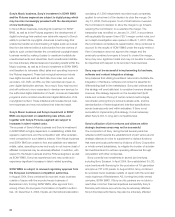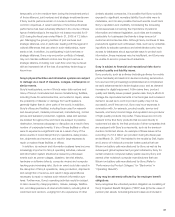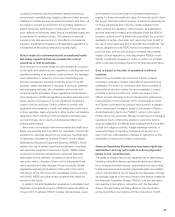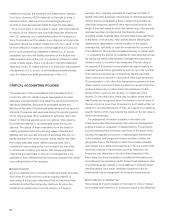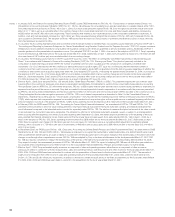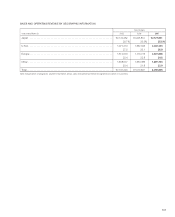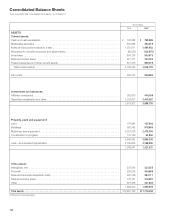Sony 2007 Annual Report Download - page 97
Download and view the complete annual report
Please find page 97 of the 2007 Sony annual report below. You can navigate through the pages in the report by either clicking on the pages listed below, or by using the keyword search tool below to find specific information within the annual report.94
Management bases its estimates of ultimate revenue for each
film on several factors including the historical performance of
similar genre films, the star power of the lead actors and
actresses, the expected number of theaters at which the film will
be released, anticipated performance in the home entertainment,
television and other ancillary markets, and agreements for future
sales. Management updates such estimates based on the
actual results to date of each film. For example, a film that has
resulted in lower than expected theatrical revenues in its initial
weeks of release would generally have its theatrical, home
entertainment and television distribution ultimate revenues
adjusted downward; a failure to do so would result in the
understatement of amortized film costs for the period.
■FUTURE INSURANCE POLICY BENEFITS
Liabilities for future insurance policy benefits are established in
amounts adequate to meet the estimated future obligations of
policies in force. These liabilities are computed by the net level
premium method based upon estimates as to future investment
yield, mortality, morbidity, withdrawals and other factors. Future
policy benefits are computed using interest rates ranging from
0.90 percent to 5.00 percent. Mortality, morbidity and with-
drawal assumptions for all policies are based on either the life
insurance subsidiary’s own experience or various actuarial
tables. Generally these assumptions are “locked-in” upon the
issuance of new insurance. While management believes that the
assumptions used are appropriate, differences in actual experi-
ence or changes in assumptions may affect Sony’s future
insurance policy benefits.
RECENTLY ADOPTED ACCOUNTING
STANDARDS
■INVENTORY COSTS
In November 2004, the Financial Accounting Standards Board
(“FASB”) issued Statement of FAS No. 151, “Inventory Costs, an
amendment of Accounting Research Bulletin No. 43, Chapter
4.” This statement requires certain abnormal expenditures to be
recognized as expenses in the current period. It also requires
that the amount of fixed production overhead allocated to the
inventory be based on the normal capacity of the production
facilities. Sony adopted FAS No. 151 on April 1, 2006. The
adoption of FAS No. 151 did not have a material impact on
Sony’s results of operations and financial position.
■ACCOUNTING FOR STOCK-BASED COMPENSATION
Effective April 1, 2006, Sony adopted FAS No. 123 (revised
2004), “Share-Based Payment” (“FAS No. 123(R)”). This
statement requires the use of the fair value-based method
of accounting for employee stock-based compensation and
eliminates the alternative to use the intrinsic value method
prescribed by Accounting Principle Board Opinion (“APB”)
No. 25. With limited exceptions, FAS No. 123(R) requires that
the grant-date fair value of share-based payments to employees
be expensed over the period the service is received. Sony had
accounted for its employee stock-based compensation in
accordance with the provisions prescribed by APB No. 25 and
its related interpretations and had disclosed the net effect on net
income and net income per share (“EPS”) allocated to the
common stock as if Sony had applied the fair value recognition
provisions of FAS No. 123 to stock-based compensation as
described in Note 2 to the Consolidated Financial Statements,
Significant accounting policies—Stock-based compensation.
Sony has elected the modified prospective method of transition
prescribed in FAS No. 123(R), which requires that compensation
expense be recorded for all unvested stock acquisition rights as
the requisite service is rendered beginning with the first period of
adoption. As a result of the adoption of FAS No. 123(R), Sony’s
operating income decreased by 3,670 million yen for the fiscal
year ended March 31, 2007.
■DERIVATIVE INSTRUMENTS AND HEDGING ACTIVITIES
In February 2006, the FASB issued FAS No. 155, “Accounting
for Certain Hybrid Financial Instruments,” an amendment of
FAS No. 133 and FAS No. 140. This statement permits an entity
to elect fair value remeasurement for any hybrid financial
instrument if the hybrid instrument contains an embedded
derivative that would otherwise be required to be bifurcated
and accounted for separately under FAS No. 133. The election
to measure the hybrid instrument at fair value is made on an
instrument-by-instrument basis and is irreversible. The state-
ment is effective for all financial instruments acquired, issued, or
subject to a remeasurement event occurring after the beginning
of an entity’s fiscal year beginning after September 15, 2006,
with earlier adoption permitted as of the beginning of the fiscal
year, provided that financial statements for any interim period
of that fiscal year have not been issued. Sony early adopted
FAS No. 155 on April 1, 2006. As a result of the adoption
of FAS No. 155, Sony’s operating income increased by
3,828 million yen for the fiscal year ended March 31, 2007.




